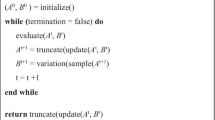Abstract
Portfolio optimization problem is an important research topic in finance. The standard model of this problem, called Markowitz mean-variance model, has two conflicting criteria: expected returns and risks. In this paper, we consider a more realistic portfolio optimization problem, including both cardinality and quantity constraints, which is called Markowitz mean-variance cardinality constrained portfolio optimization problem (MVCCPO problem). We extend an algorithm which is based on a multi-objective evolutionary framework incorporating a local search schema and non-dominated sorting. To quantitatively analyze the effectiveness of the proposed algorithm, we compared our algorithm with the other five algorithms on public available data sets involving up to 225 assets. Several modifications based on the fundamental operators and procedures of the algorithm, namely, the boundary constraint handling strategy, the local search schema, the replacement strategy and the farthest-candidate approach, are proposed one-by-one. Success of this exercise is displayed via simulation results. The experimental results with different cardinality constraints illustrate that the proposed algorithm outperforms the other algorithms in terms of proximity and diversity. In addition, the diversity maintenance strategy used in the algorithm is also studied in terms of a spread metric to evaluate the distribution of the obtained non-dominated solutions. The sensitivity of our algorithm has also been experimentally investigated in this paper.








Similar content being viewed by others
References
Markowitz HM (1952) Portfolio select. J Financ 7(1):7791
Markowitz HM (1956) The optimization of a quadratic function subject to linear constraints. Nav Res Log Quart 3(1-2):111133
Chang TJ, Meade N, Beasley JE, Sharaiha YM (2000) Heuristics for cardinality constrained portfolio optimisation. Comput Oper Res 27(11):1271–1302
Bienstock D (1996) Computational study of a family of mixed-integer quadratic programming problems. Math Program 74(2):121–140
Jobst NJ, Horniman MD, Lucas CA, Mitra G (2001) Computational aspects of alternative portfolio selection models in the presence of discrete asset choice constraints. Quant Financ 1(3):489–501
Li D, Sun X, Wang J (2006) Optimal lot solution to cardinality constrained meanvariance formulation for portfolio selection. Math Financ 16(1):83–101
Shaw DX, Liu S, Kopman L (2008) Lagrangian relaxation procedure for cardinality-constrained portfolio optimization. Optim Methods Softw 23(1):411–420
Vielma JP, Ahmed S, Nemhauser GL (2008) A lifted linear programming branchand-bound algorithm for mixed-integer conic quadratic programs. INFORMS J Comput 20(1):438–450
Bertsimas D, Shioda R (2009) Algorithm for cardinality-constrained quadratic optimization. Comput Optim Appl 43(1):1–22
Gulpinar N, An LTH, Moeini M (2010) Robust investment strategies with discrete asset choice constraints using DC programming. Optimization 59(1):45–62
Padhye N, Bhardawaj P, Deb K (2013) Improving differential evolution through a unified approach. J Global Optim 55(2):771–799
Deb K, Padhye N (2014) Enhancing performance of particle swarm optimization through an algorithmic link with genetic algorithms. Comput Optim Appl 57(1):761–794
Deb K, Ptratap A, Agarwal S, Meyarivan T (2002) A fast and elitist multiobjective genetic algorithm: NSGA II. IEEE Trans Evol Comput 6(2):182–197
Zitzler E, Laumanns M, Thiele L (2001) SPEA2: Improving the strength Pareto evolutionary algorithm. TIK-103. Department of Electrical Engineering, Swiss Federal Institute of Technology, Zurich, Switzerland
Chen BL, Zeng WH, Lin YB, Zhang DF (2015) A new local search-based multiobjective optimization algorithm. IEEE trans Evol Comput 19(1):50–73
Zhang QF, Li H (2007) MOEA/D: A multi-objective evolutionary algorithm based on decomposition. IEEE Trans Evol Comput 11(4):712–731
Li H, Zhang QF (2009) Multiobjective optimization problems with complicated pareto sets. MOEA/D NSGA-II IEEE Trans Evol Comput 13(2):284–302
Jiang S, Yang S (2016) An improved multiobjective optimization evolutionary algorithm based on decomposition for complex pareto fronts. IEEE Trans Cybern 46(2):421–437
Li K, Kwong S, Deb K (2015) A dual-population paradigm for evolutionary multiobjective optimization. Inform Sci 309:50–72
Zhang X, Tian Y, Cheng R, Jin Y (2015) An efficient approach to nondominated sorting for evolutionary multiobjective optimization. IEEE Trans Evol Comput 19(2):201–213
Zhu Q, Lin Q, Du Z, Liang Z, Wang W, Zhu Z, Chen J, Huang P, Ming Z (2016) A novel adaptive hybrid crossover operator for multiobjective evolutionary algorithm. Inform Sci 345:177–198
Shim VA, Tang TKC (2015) Adaptive memetic computing for evolutionary multiobjective optimization. IEEE Trans Cybern 45(2):610–621
Schaerf A (2002) Local search techniques for constrained portfolio selection problems. Comput Econ 20(1):170–190
Crama Y, Schyns M (2003) Simulated annealing for complex portfolio selection problems. Eur J Oper Resh 150(1):546–571
Derigs U, Nickel NH (2003) Metaheuristic based decision support for portfolio optimisation with a case study on tracking error minimization in passive portfolio management. OR Spectr 25(25):345–378
Derigs U, Nickel N-H (2004) On a local-search heuristic for a class of tracking error minimization problems in portfolio management. Ann Oper Res 131(131):45–77
Ehrgott M, Klamroth K, Schwehm C (2004) An MCDM approach to portfolio optimization. Eur J Oper Res 155(1):752–770
Streichert F, Tanaka-Yamawaki M (2006) The effect of local search on the constrained portfolio selection problem. In: Proceedings of the 2006 IEEE Congress on Evolutionary Computation, pp 2368–2374
Fernández A, Gómez S (2007) Portfolio selection using neural networks. Comput Oper Res 34(2):1177–1191
Chiam SC, Tan KC, Al Mamum A (2008) Evolutionary multi-objective portfolio optimization in practical context. Int J Autom Comput 5(1):67–80
Branke J, Scheckenbach B, Stein M, Deb K, Schmeck H (2009) Portfolio optimization with an envelope-based multi-objective evolutionary algorithm. Eur J Oper Res 199(1):684–693
Cura T (2009) Particle swarm optimization approach to portfolio optimization. Nonlinear Anal Real 10 (2):2396–2406
Pai GAV, Michel T (2009) Evolutionary optimization of constrained k-means clustered assets for diversification in small portfolios. IEEE Trans Evol Comput 13(3):1030–1053
Soleimani H, Golmakani HR, Salimi MH (2009) Markowitz-based portfolio selection with minimum transaction lots, cardinality constraints and regarding sector capitalization using genetic algorithm. Expert Syst Appl 36(1):5058–5063
Chang TJ, Yang SC, Chang KJ (2009) Portfolio optimization problems in different risk measures using genetic algorithm. Expert Syst Appl 36(5):10529–10537
Anagnostopoulos KP, Mamanis G (2010) A portfolio optimization model with three objectives and discrete variables. Comput Oper Res 37(5):1285–1297
Corne DW, Knowles JD, Oates MJ The Pareto envelope-based selection algorithm for multi-objective optimization. In: Proceedings of the parallel problem solving from nature (PPSN VI), pp 839–848
Anagnostopoulos KP, Mamanis G (2011) The mean–variance cardinality constrained portfolio optimization problem: An experimental evaluation of five multiobjective evolutionary algorithms. Expert Syst Appl 38 (9):14208–14217
Erickson MA, Maye HJ (1993) The niched pareto genetic algorithm 2 applied to the design of groundwater remediation systems. Lect Notes Comput Sci 1993(1993):681–695
Hanne T (2007) A multiobjective evolutionary algorithm for approximating the efficient set. Eur J Oper Res 176(1):1723–1734
Ruiz-Torrubiano R, Suarez A (2010) Hybrid approaches and dimensionality reduction for portfolio selection with cardinality constraints. IEEE Comput Intel Mag 5(2):92–107
Woodside-Oriakhi M, Lucas C, Beasley JE (2011) Heuristic algorithms for the cardinality constrained efficient frontier. Eur J Oper Res 538550(1)
Lwin K Qu R (2013) A hybrid algorithm for constrained portfolio selection problems. Appl Intel 39(2):251–266
Murray W, Shek H (2012) A local relaxation method for the cardinality constrained portfolio optimization problem. Comput Optim Appl 681709(1)
Deng GF, Lin WT, Lo CC (2012) Markowitz-based portfolio selection with cardinality constraints using improved particle swarm optimization. Expert Syst Appl 39(2):4558–4566
Liagkouras K, Metaxiotis K (2014) A new probe guided mutation operator and its application for solving the cardinality constrained portfolio optimization problem. Expert Syst Appl 41(12):6274–6290
Tuba M, Bacanin N (2014) Artificial bee colony algorithm hybridized with firefly algorithm for cardinality constrained mean-variance portfolio selection problem. Appl Math Inform Sci 8(4):2831–2844
Cui T, Cheng S, Bai R (2014) A combinatorial algorithm for the cardinality constrained portfolio optimization problem
Baykasoğlu A, Yunusoglu MG, Özsoydan F B (2015) A grasp based solution approach to solve cardinality constrained portfolio optimization problems. Comput Ind Eng 90(C):339–351
Ruiz-Torrubiano R, Suárez A (2015) A memetic algorithm for cardinality-constrained portfolio optimization with transaction costs. Appl Soft Comput 36(C):125–142
Metaxiotis K, Liagkouras K (2012) Multiobjective evolutionary algorithms for portfolio management: A comprehensive literature reviews. Expert Syst Appl 39(12):11685–11698
Holland JH (1975) Adaptation in Natural and Artificial Systems: An Introductory Analysis With Applications to Biology, Control, and Artificial Intelligence. University of Michigan Press, MI, USA
Padhye N, Mittal P, Deb K (2015) Feasibility preserving constraint-handling strategies for real parameter evolutionary optimization. Comput Optim Appl 62(1):851–890
Zitzler E, Thiele L, Laumanns M, Fonseca CM, Da Fonseca VG (2003) Performance assessment of multiobjective optimizers: An analysis and review. IEEE Trans Evol Comput 7(2):117–132
Cesarone F, Tardella SA (2008) Efficient algorithms for mean-variance portfolio optimization with real-world constraints. In: Proceedings of the 18th AFIR colloquium: Financial risk in a changing world, Rome
Wang YN, Wu LH, Yuan XF (2010) Multi-objective self-adaptive differential evolution with elitist archive and crowding entropy-based diversity measure. Soft Comput 14(1):193–209
Garcia S, Molina D, Lozano M, Herrera F (2009) A Study on the use of nonparametric tests for analyzing the evolutionary algorithms’ behaviour: A case study on the CEC’2005 special session on real parameter optimization. J Heuristics 15(4):617–644
Rechenberg I (1971) Evolutionsstrategie: Optimierung technischer Systeme nach Prinzipiender biologischen Evolution. Ph.D. Thesis, Technical University of Berlin, Department of Process Engineering
Rechenberg I (1973) Evolutionsstrategie: Optimierung technischer systeme nach prinzipien der biologischen evolution. Frommann-Holzboog Verlag, Stuttgart
Acknowledgments
This work is supported by the National Nature Science Foundation of China under Grant No. 61272003, No. 60672018, No.40774065 and the Natural Science Foundation of Fujian Province, China under Grant No. 2013h0032, No. 2013j01243.
Author information
Authors and Affiliations
Corresponding author
Rights and permissions
About this article
Cite this article
Chen, B., Lin, Y., Zeng, W. et al. The mean-variance cardinality constrained portfolio optimization problem using a local search-based multi-objective evolutionary algorithm. Appl Intell 47, 505–525 (2017). https://doi.org/10.1007/s10489-017-0898-z
Published:
Issue Date:
DOI: https://doi.org/10.1007/s10489-017-0898-z




